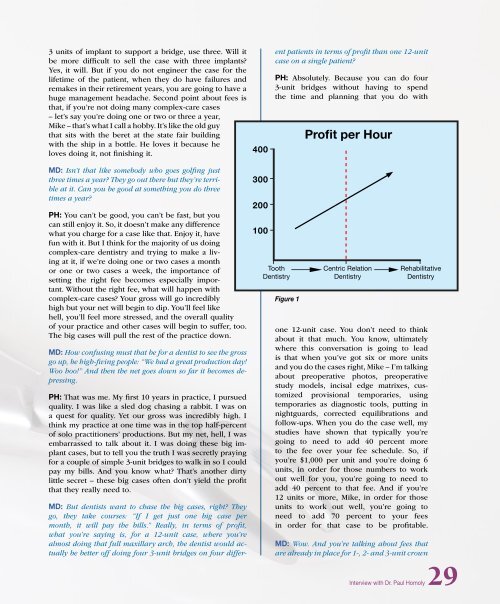PDF Version - Glidewell Dental Labs
PDF Version - Glidewell Dental Labs
PDF Version - Glidewell Dental Labs
Create successful ePaper yourself
Turn your PDF publications into a flip-book with our unique Google optimized e-Paper software.
3 units of implant to support a bridge, use three. Will it<br />
be more difficult to sell the case with three implants?<br />
Yes, it will. But if you do not engineer the case for the<br />
lifetime of the patient, when they do have failures and<br />
remakes in their retirement years, you are going to have a<br />
huge management headache. Second point about fees is<br />
that, if you’re not doing many complex-care cases<br />
– let’s say you’re doing one or two or three a year,<br />
Mike – that’s what I call a hobby. It’s like the old guy<br />
that sits with the beret at the state fair building<br />
with the ship in a bottle. He loves it because he<br />
loves doing it, not finishing it.<br />
400<br />
MD: But dentists want to chase the big cases, right? They<br />
go, they take courses: “If I get just one big case per<br />
month, it will pay the bills.” Really, in terms of profit,<br />
what you’re saying is, for a 12-unit case, where you’re<br />
almost doing that full maxillary arch, the dentist would actually<br />
be better off doing four 3-unit bridges on four different<br />
patients in terms of profit than one 12-unit<br />
case on a single patient?<br />
PH: Absolutely. Because you can do four<br />
3-unit bridges without having to spend<br />
the time and planning that you do with<br />
Profit per Hour<br />
MD: Isn’t that like somebody who goes golfing just<br />
three times a year? They go out there but they’re terrible<br />
at it. Can you be good at something you do three<br />
times a year?<br />
PH: You can’t be good, you can’t be fast, but you<br />
can still enjoy it. So, it doesn’t make any difference<br />
what you charge for a case like that. Enjoy it, have<br />
fun with it. But I think for the majority of us doing<br />
complex-care dentistry and trying to make a living<br />
at it, if we’re doing one or two cases a month<br />
or one or two cases a week, the importance of<br />
setting the right fee becomes especially important.<br />
Without the right fee, what will happen with<br />
complex-care cases? Your gross will go incredibly<br />
high but your net will begin to dip. You’ll feel like<br />
hell, you’ll feel more stressed, and the overall quality<br />
of your practice and other cases will begin to suffer, too.<br />
The big cases will pull the rest of the practice down.<br />
MD: How confusing must that be for a dentist to see the gross<br />
go up, be high-fiving people: “We had a great production day!<br />
Woo hoo!” And then the net goes down so far it becomes depressing.<br />
PH: That was me. My first 10 years in practice, I pursued<br />
quality. I was like a sled dog chasing a rabbit. I was on<br />
a quest for quality. Yet our gross was incredibly high. I<br />
think my practice at one time was in the top half-percent<br />
of solo practitioners’ productions. But my net, hell, I was<br />
embarrassed to talk about it. I was doing these big implant<br />
cases, but to tell you the truth I was secretly praying<br />
for a couple of simple 3-unit bridges to walk in so I could<br />
pay my bills. And you know what? That’s another dirty<br />
little secret – these big cases often don’t yield the profit<br />
that they really need to.<br />
300<br />
200<br />
100<br />
Tooth<br />
Dentistry<br />
Figure 1<br />
Centric Relation<br />
Dentistry<br />
Rehabilitative<br />
Dentistry<br />
one 12-unit case. You don’t need to think<br />
about it that much. You know, ultimately<br />
where this conversation is going to lead<br />
is that when you’ve got six or more units<br />
and you do the cases right, Mike – I’m talking<br />
about preoperative photos, preoperative<br />
study models, incisal edge matrixes, customized<br />
provisional temporaries, using<br />
temporaries as diagnostic tools, putting in<br />
nightguards, corrected equilibrations and<br />
follow-ups. When you do the case well, my<br />
studies have shown that typically you’re<br />
going to need to add 40 percent more<br />
to the fee over your fee schedule. So, if<br />
you’re $1,000 per unit and you’re doing 6<br />
units, in order for those numbers to work<br />
out well for you, you’re going to need to<br />
add 40 percent to that fee. And if you’re<br />
12 units or more, Mike, in order for those<br />
units to work out well, you’re going to<br />
need to add 70 percent to your fees<br />
in order for that case to be profitable.<br />
MD: Wow. And you’re talking about fees that<br />
are already in place for 1-, 2- and 3-unit crown<br />
Interview with Dr. Paul Homoly29

















